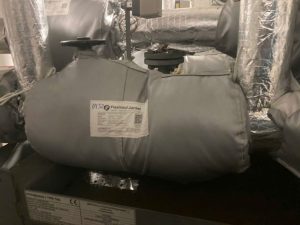Excessively high surface temperatures on valves and fittings in steam piping systems are a common problem in factories. This situation not only causes significant energy loss, increasing operational costs, but also poses a potential workplace safety hazard.
This article analyzes a real-world case study where the application of insulation jackets (removable blankets) helped a business immediately reduce valve surface temperatures by 15°C, delivering dual benefits in cost savings and personnel protection.
The Problem with Uninsulated Steam Valves: The Factory’s “Silent Enemy”
In industrial plants, steam piping systems are often thoroughly insulated, but components like valves, flanges, and fittings are frequently overlooked. These are critical weak points that create numerous challenges:
- Massive Energy Waste: The hot surface of a valve acts like a radiator, continuously losing heat to the environment. This forces the system to consume more fuel to maintain the required temperature and pressure.
- Workplace Safety Risks: High surface temperatures can cause severe burns to operators upon accidental contact, especially in confined spaces.
- Harsh Working Environment: The radiated heat increases the ambient air temperature, creating uncomfortable conditions that can affect workers’ health and concentration.
At the factory in question, technicians recorded consistently high surface temperatures on a critical steam valve assembly, leading to significant energy losses and increased monthly operating costs.
Steam Valve Insulation Jackets: A Smart and Flexible Insulation Solution
To comprehensively address these issues, the chosen solution was to install removable insulation jackets, custom-designed for each type of valve and fitting on the pipeline.
Superior Construction
Specialized insulation jackets are constructed from multiple layers of high-performance materials:
- Insulation Core Layer: Typically made from ceramic fiber, fiberglass, or aerogel, which offer excellent high-temperature resistance and superior insulation properties.
- Protective Outer Shell: The outer cover is made from heat-resistant, waterproof, and chemical-resistant fabric that is easy to clean, protecting the core from the industrial environment.
- Custom-Fit Design: Each insulation jacket is designed and tailored to the exact size and shape of the specific valve, ensuring a snug fit with no gaps that could cause heat loss.
Simple Installation, Easy Maintenance
With a design featuring straps, buckles, and D-rings, installing or removing the insulation jackets for valve inspection and maintenance is extremely fast. This task does not require complex tools or specialized skills, saving time and labor.
Real-World Effectiveness: A 15°C Reduction and More
Immediately after the installation of the insulation jacket system was completed, surface temperature measurements showed impressive results.
The temperature on the outer surface of the insulation jacket had dropped by an average of 15°C compared to before. This change is more than just a number; it delivers comprehensive benefits:
- Maximum Safety: The risk of burns for operators is almost completely eliminated, creating a safer working environment.
- Significant Energy Savings: Reduced heat loss means less fuel is consumed to maintain system temperature. This directly lowers monthly energy bills.
- Improved System Efficiency: Steam maintains a more stable temperature during transport, enhancing the efficiency of end-use production equipment.
- Fast Return on Investment (ROI): The investment cost for insulation jackets is typically recovered in a short period (usually from a few months to over a year) thanks to energy savings.
- Extended Equipment Lifespan: Insulation jackets also protect valves from dust, chemicals, and other environmental impacts, helping to extend the equipment’s service life.
Conclusion
The case study above is clear evidence that an insulation jacket is a smart, effective, and necessary investment for any business that uses a steam system. Reducing the surface temperature by 15°C not only solves a safety issue but also represents a strategic step toward optimizing operating costs and improving production efficiency.
If your factory is facing heat loss issues, consider specialized insulation jackets to protect your personnel, equipment, and bottom line.
Request consultation and quotation now!Frequently Asked Questions
Why is it necessary to insulate steam valves and pipes?
Insulating steam valves and pipes helps reduce heat loss, save energy costs, enhance workplace safety by lowering surface temperatures, and protect equipment from environmental factors.
Do insulation jackets help save significant costs?
Yes. By significantly reducing heat loss, insulation jackets help lower fuel consumption. The investment cost can often be recouped in a short period, depending on the system’s temperature and scale.
Are insulation jackets easy to remove for valve maintenance?
Very easy. Insulation jackets are designed with specialized straps and fasteners, allowing for quick removal and installation by hand without complex tools, making periodic inspections and maintenance convenient.
What is the average lifespan of an industrial insulation jacket?
The lifespan of an insulation jacket depends on the materials and the working environment, but high-quality products can typically last for many years.
What materials are insulation jackets made from?
Insulation jackets typically have a multi-layer construction, with a core made of high-performance insulation materials like ceramic fiber, fiberglass, or aerogel, and an outer shell made of heat-resistant, waterproof materials like silicone or Teflon-coated fabric.
What other equipment can insulation jackets be used for besides valves?
Insulation jackets can be custom-designed for almost any component in a piping system, such as flanges, elbows, steam traps, filters, condensers, and even large equipment like boiler bodies and turbines.










